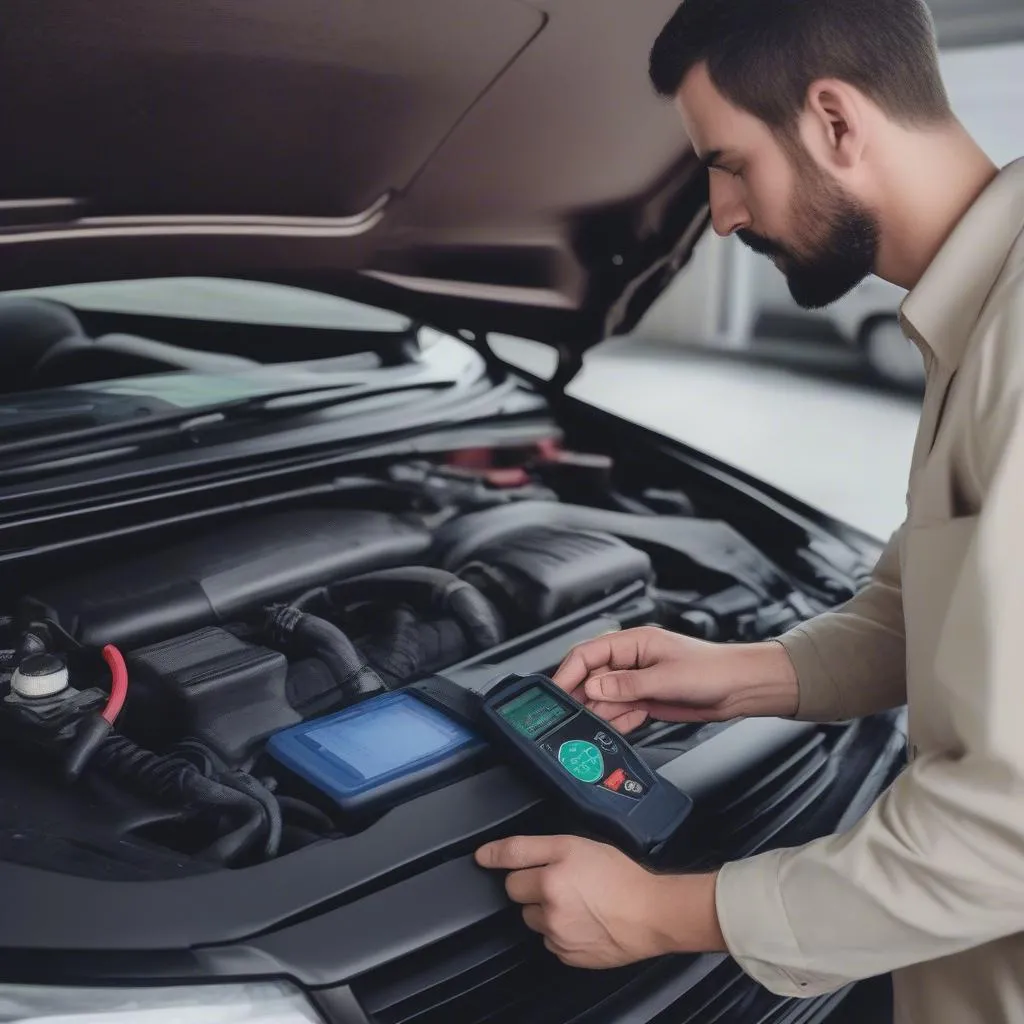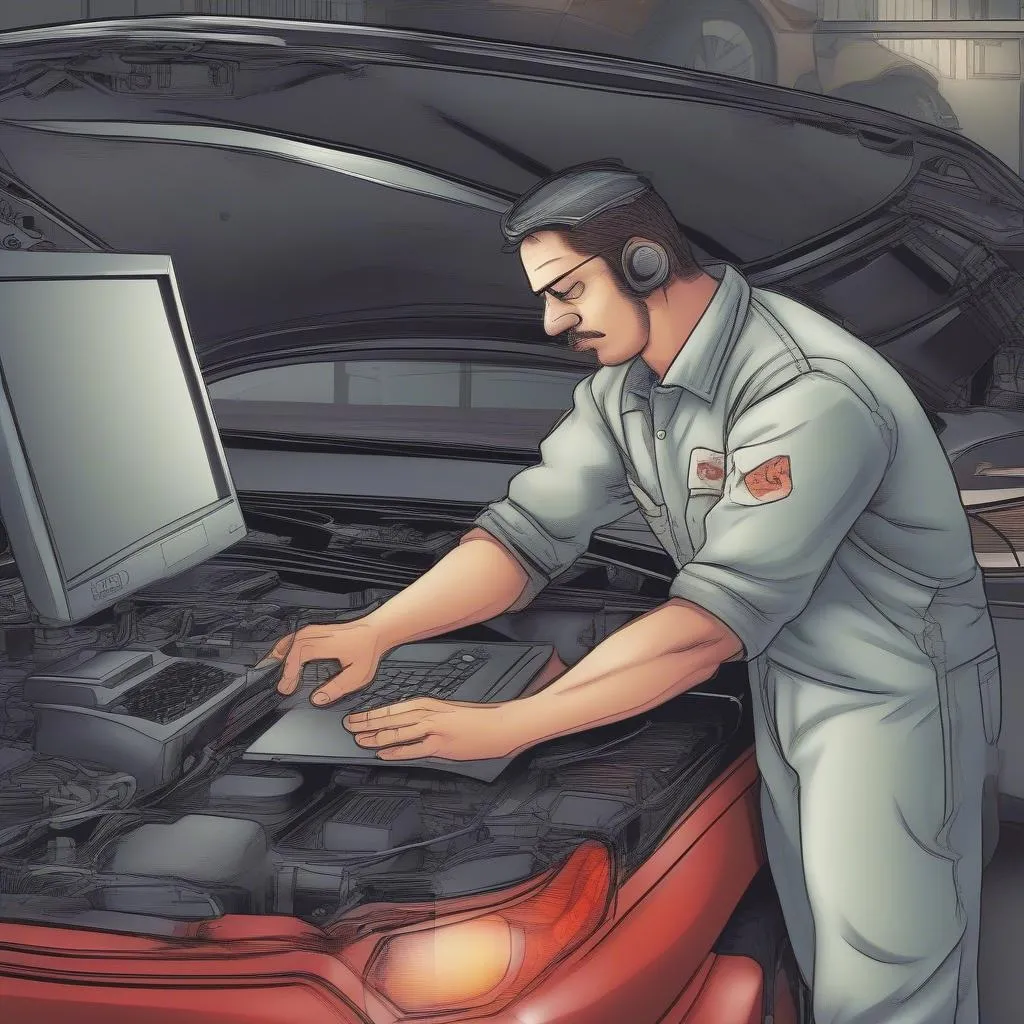You’re cruising down the highway, enjoying the open road, when suddenly your car’s “check engine light” flickers on. A wave of anxiety washes over you. What could it be? Is it something minor, or a major engine problem? It’s moments like these you realize the importance of a check engine light scanner. This little device can be your car’s personal translator, helping you understand what those cryptic engine codes mean and guide you towards a solution.
Understanding the “Check Engine Light”
The “check engine light,” sometimes referred to as the “service engine soon” light, is a crucial warning indicator on your car’s dashboard. It signals that the car’s onboard computer (called the Engine Control Unit, or ECU) has detected a fault within the vehicle’s emission system. This can range from a loose gas cap to a serious engine issue.
Think of the check engine light like your car’s “silent SOS.” Without a check engine light scanner, you’re left with only a flashing light and a nagging question: “What’s wrong with my car?”
Deciphering the Codes: Unlocking Your Car’s Secrets
A check engine light scanner, also known as an OBD2 scanner, acts as a mediator between your car’s ECU and your understanding. Here’s how it works:
- Connection: The scanner plugs into the OBD2 port, typically found under the dashboard or near the steering column.
- Reading: It reads the error codes stored in the ECU.
- Translation: The scanner translates these codes into plain English descriptions, providing insights into the potential problem.
Common Uses of Check Engine Light Scanners
1. Troubleshooting Engine Issues: You can identify the cause of a “check engine light” and troubleshoot it yourself. A simple fix, like tightening a loose gas cap, can be easily resolved with the help of a scanner.
2. Diagnosing Emission Problems: If your car fails an emissions test, a check engine light scanner can identify the cause, saving you time and money.
3. Clearing Codes: Once the issue is resolved, the scanner can clear the codes stored in the ECU, turning off the “check engine light.”
4. Monitoring Vehicle Data: Some advanced scanners can monitor real-time data, such as engine speed, fuel pressure, and oxygen sensor readings, helping to identify potential problems before they become serious.
Types of Check Engine Light Scanners
1. Basic OBD2 Scanners: These inexpensive scanners read and clear codes, but they offer limited information and data.
2. Advanced Scanners: These scanners provide more detailed information, including live data streams, diagnostic trouble codes (DTCs) descriptions, and even freeze frame data, which captures conditions at the moment the fault occurred.
3. Dealer-Level Scanners: These professional-grade scanners are used by dealerships and mechanics to access advanced diagnostic information specific to particular car models.
4. Smartphone Apps: Many apps use Bluetooth to connect to your car’s OBD2 port, offering basic diagnostics and data readings.
 OBD2 Scanner
OBD2 Scanner
Choosing the Right Check Engine Light Scanner
The best check engine light scanner for you depends on your needs and budget. Consider:
1. Your Car’s Year and Make: Ensure the scanner is compatible with your car’s OBD2 protocol.
2. Level of Detail: Do you need a basic scanner for simple troubleshooting, or a more advanced scanner for in-depth diagnostics?
3. Features: Consider features like live data readings, freeze frame data, and the ability to clear codes.
4. Budget: Scanners range in price, so set a budget before you start shopping.
FAQs
1. How do I know which OBD2 scanner to buy for my car?
It’s important to choose a scanner that’s compatible with your car’s make and model. Look for scanners that support the OBD2 protocol for your vehicle’s year.
2. Is it worth it to invest in a check engine light scanner?
Absolutely! A check engine light scanner can save you time, money, and stress by helping you understand your car’s problems and potentially fix them yourself.
3. Can I use a check engine light scanner to clear the codes myself?
Yes, most scanners have the ability to clear codes. However, it’s important to understand the underlying issue before clearing the code. If the problem persists, the light will likely reappear.
4. What are some of the most common reasons for a check engine light to come on?
Some common causes include a loose gas cap, faulty oxygen sensor, clogged catalytic converter, and problems with the ignition system.
 Check Engine Light Codes
Check Engine Light Codes
Get the Information You Need
Understanding your car’s “check engine light” can seem daunting. But with a check engine light scanner, you can gain valuable insight into your car’s health. If you’re unsure about using a scanner or need additional support, we offer a range of services and diagnostics tools.
Need help with your check engine light? Reach out to us on WhatsApp: +84767531508 for expert assistance.
Keep Exploring
Want to learn more about car diagnostics? Explore our website and articles:
- Autel Scanner to Diagnosis a Hyundai Check Engine Ligth
- Autel OBD2 Scanner Didn’t Clear Check Engine Light
- Autel OBD2 Scanner MS309 Check Engine Code Reader
- OBD2 Scanner App
- OBD-1 and 2 Scanner
Don’t let the “check engine light” be a source of stress. Empower yourself with knowledge and a check engine light scanner!
 Car Diagnostics
Car Diagnostics
Share your experiences with check engine light scanners and ask your questions in the comments section below!